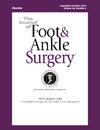Open Ankle Fractures in Older Individuals: A Multi-center Study
IF 1.3
4区 医学
Q2 Medicine
引用次数: 0
Abstract
The purpose of this study is to identify demographics, etiology, comorbidities, treatment, complications, and outcomes for older patients with open ankle fractures. Patients ≥60 years old who sustained an open ankle fracture between January 1, 2004 and March 31, 2014 at 6 Level 1 trauma centers were retrospectively reviewed. Univariate analysis using chi-squared or Student's t test was performed to identify associations between preoperative variables and 2 postoperative outcomes of interest: amputation and 1-year mortality. Multivariate analysis was performed using stepwise logistical regression to identify independent predictors of postoperative amputation and 1-year mortality. Of the 162 total patients, the most common mechanism of injury was a ground-level fall (51.9%). The most common fracture types were bimalleolar fractures (52.5%) followed by trimalleolar fractures (26.5%), with 41.5% of the fractures classified as Gustilo Anderson Classification Type 2 and 38.6% classified as Type 3A. The average number of surgeries required per patient was 2.1. Complications included: 15.4% superficial infection rate, 9.9% deep infection rate, and 9.3% amputation rate. The 1-year mortality rate was 13.6% and the overall mortality rate was 25.9%. Male gender and fracture type were found to be independent predictors for amputation after surgery (p = .009, .005, respectively). Older age and having diabetes were independent predictors for 1-year mortality after surgery (p = .021, .005 respectively). Overall, open ankle fractures in older individuals were associated with high rates of amputation and mortality.
老年人开放性踝关节骨折:一项多中心研究
本研究旨在确定老年开放性踝关节骨折患者的人口统计学、病因学、合并症、治疗、并发症和预后。研究人员对 6 家一级创伤中心 2004 年 1 月 1 日至 2014 年 3 月 31 日期间≥60 岁的开放性踝关节骨折患者进行了回顾性研究。采用卡方检验或学生 T 检验进行单变量分析,以确定术前变量与两种术后结果(截肢和 1 年死亡率)之间的关系。使用逐步逻辑回归法进行多变量分析,以确定术后截肢和 1 年死亡率的独立预测因素。在所有162名患者中,最常见的受伤机制是地面摔伤(51.9%)。最常见的骨折类型是双极骨折(52.5%),其次是三极骨折(26.5%),41.5%的骨折被归类为古斯蒂洛-安德森分类法2型,38.6%被归类为3A型。每位患者平均需要进行 2.1 次手术。并发症包括表皮感染率为 15.4%,深部感染率为 9.9%,截肢率为 9.3%。1年死亡率为13.6%,总死亡率为25.9%。男性性别和骨折类型是术后截肢的独立预测因素(P = 0.009,0.005)。年龄较大和患有糖尿病是手术后 1 年死亡率的独立预测因素(P = 0.021,0.005)。总体而言,老年人开放性踝关节骨折的截肢率和死亡率都很高。
本文章由计算机程序翻译,如有差异,请以英文原文为准。
求助全文
约1分钟内获得全文
求助全文
来源期刊

Journal of Foot & Ankle Surgery
ORTHOPEDICS-SURGERY
CiteScore
2.30
自引率
7.70%
发文量
234
审稿时长
29.8 weeks
期刊介绍:
The Journal of Foot & Ankle Surgery is the leading source for original, clinically-focused articles on the surgical and medical management of the foot and ankle. Each bi-monthly, peer-reviewed issue addresses relevant topics to the profession, such as: adult reconstruction of the forefoot; adult reconstruction of the hindfoot and ankle; diabetes; medicine/rheumatology; pediatrics; research; sports medicine; trauma; and tumors.
 求助内容:
求助内容: 应助结果提醒方式:
应助结果提醒方式:


